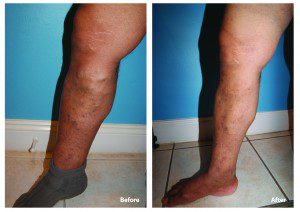By Joseph Magnant, MD, FACS, RPVI
 Venous insufficiency, or leaky veins, is often the underlying cause of many seemingly unrelated symptoms such as night time leg cramps, Charley horses, restless legs syndrome and night time urination.
Venous insufficiency, or leaky veins, is often the underlying cause of many seemingly unrelated symptoms such as night time leg cramps, Charley horses, restless legs syndrome and night time urination.
Manuel Avalos, Jr. confided that his nighttime leg cramping had become very severe.
“Years ago, I noticed that I was developing varicose veins in my right leg,” admits the 61 year old farmer. “My mother had varicose veins and throughout the years, she had numerous operations to try and resolve them.”
Historically, until the year 2000, the only treatment available to offer patients with venous insufficiency was surgical vein excisions, or vein stripping, which often required hospitalization and general anesthesia along with an extended recovery period.
“However,” continued Manuel, “I normally don’t like to go to doctors, so I just let it go.”
He says that his most recent job required extensive, long-distance driving: “As time went on, the veins in my leg were getting very big, very bulgy. My right ankle began swelling up. It looked black, red, and dark purple from my ankle up my leg for about six inches. Then I developed nighttime leg cramping. Friends recommended I try drinking a bit of vinegar, but it didn’t cure anything. I continued with my normal activities, but the cramping got worse. It was very painful. I would get out of bed and try to walk and stretch my leg, and eventually the pain would diminish, but the following day my muscles would be aching. I was having cramps at least twice a week and because of it I was in a lot of pain and couldn’t sleep. I finally said to my wife, I need to take care of this.”
Manuel says his daughter accompanied him to see Joseph G. Magnant, MD, FACS, RPVI, a board-certified vascular surgeon who specializes in vein treatment. His practice, Vein Specialists at Royal Palm Square in Fort Myers, is 100% dedicated to the modern evaluation and treatment of leg vein disorders.
“Manuel presented with extensive problems in his right leg,” remembers Dr. Magnant. “In his case, his venous insufficiency was visually obvious, with bulging veins and his swollen, discolored ankle. However, patients with venous insufficiency don’t always have external signs. They may present with night time leg cramps or heavy, tired, or fatigued legs, but no obvious visual signs of venous disease like varicose veins.”
What is Venous Insufficiency?
Healthy leg veins typically have a series of valves that open in one direction, allowing for flow in a segmental fashion from the feet up toward the heart. When the valves no longer close tightly, venous blood refluxes back down toward the feet, resulting in increased pressure in the leg veins, which can lead to many symptoms including leg swelling and aching, skin discoloration, leg ulcerations, and excessive nighttime urination. If not treated, the skin can become so thinned out, or effaced, over time that even exposure to hot water may cause the skin to begin bleeding. Venous insufficiency can also lead to thrombosis, or clotting of the veins, which can progress to potentially life-threatening DVT and pulmonary embolism.”
The doctor explains that diagnostic ultrasound is a very accurate, conservative, and noninvasive diagnostic tool that is the gold standard in making the diagnosis of venous insufficiency: “We rely heavily on ultrasound evaluation of our patients’ veins.”
“With ultrasound, which is usually covered by patients’ health insurance, we can determine the exact source of the problem,” assures the doctor. “We can see exactly which veins are leaking, and then design a game plan to solve the problem.”
Manuel’s ultrasound confirmed that he had venous insufficiency in his right leg.
“Unlike in the past, today, leaky superficial veins can be treated with a choice of minimally invasive, in-office procedures,” assures Dr. Magnant. “In 1999, the first FDA-approved system was the radiofrequency-based closure system designed by VNUS Medical Technologies.”
“It was really a game changer in terms of treating patients with venous disease.”
Inserting a small caliber, sophisticated catheter into the vein through a small IV, Radiofrequency or LASER energy is transmitted through the device, heating the vein to seal the vein walls with little discomfort to the patient, informs Dr. Magnant: “Once the ablation takes place, which, on average, takes approximately fifteen to twenty minutes, the catheter is removed. Subsequently, the body re-routes blood through healthier leg veins, restoring normal circulation.”
“We offer both the Venefit™ procedure [formerly called the VNUS Closure procedure using radiofrequency energy] and the Cooltouch LASER for our patients because each system has its place in the treatment of patients with venous disease. Both the Venefit and LASER systems allow us to treat patients in the office without anesthesia risks, and patients can return to normal activities almost immediately.”
For Manuel, Dr. Magnant performed laser endovenous ablation of the right great saphenous vein on December 12, 2012.
Successful Outcome
According to Manuel, he has not had any leg cramps since his procedure.
The doctor explains that when veins are leaking significantly, the normal pressure in the veins around the ankles can escalate from a normal 10 to 15 mmHg to as high as 80 mmHg: “Once the pressure is relieved, the cramping stops.”
“I love Dr. Magnant,” states Manuel. “I feel very good now. I went bicycling this morning wearing shorts. There is a huge comparison between how my leg looked before and after the procedure. I don’t see any varicose veins.”
Don’t Wait if You Have These Symptoms
Patients with any of the following symptoms might benefit from a thorough venous insufficiency evaluation, including a diagnostic ultrasound. Go to www.eveinscreening.com and take your confidential vein screening NOW!
. Swollen, achy legs
. Restless Leg Syndrome
. Bulging varicose veins
. Bleeding from spider or varicose veins
. Urination frequency at night
. Impending or open leg ulcers
. Nighttime leg cramps
. Thickening and discoloration of skin of the ankles or legs
Risk Factors for Venous Insufficiency
• Heredity – Risks for venous insufficiency are higher if other family members have venous insufficiency or varicose veins. Genetics is the primary cause.
• Gender – Women are more likely to have venous insufficiency than men. Female hormones tend to relax vein walls, and hormonal changes during pregnancy, premenstruation, or menopause may be a significant factor.
• Occupation – Standing or sitting continuously for long periods of time, such as careers in hairdressing or computer programming may require, can have an adverse effect on venous circulation.
• Obesity – Extra weight places more pressure
on veins.
• Age – Aging places more wear and tear on vein valves, increasing the probability of leaky veins.
Leaders in Vein Treatment
The modern evaluation and treatment of venous insufficiency is the singular focus of Dr. Magnant and his professional and compassionate staff at Vein Specialists in Fort Myers and Bonita Springs, FL. He can be contacted either by calling 239-694-8346 or through his website, www.weknowveins.com, where patients can submit their request for an appointment. He encourages readers to review his website which is specifically written for his patients and also take the time to view his photo gallery. Venous disease is not a laughing matter, but sometimes it is only through humor that some of us are motivated to act.
Obtain your FREE virtual vein consult now!
Scan the QR code or log on to eVeinscreening.com
Joseph Magnant, MD, FACS, RPVI
239.694.VEIN (8346)









